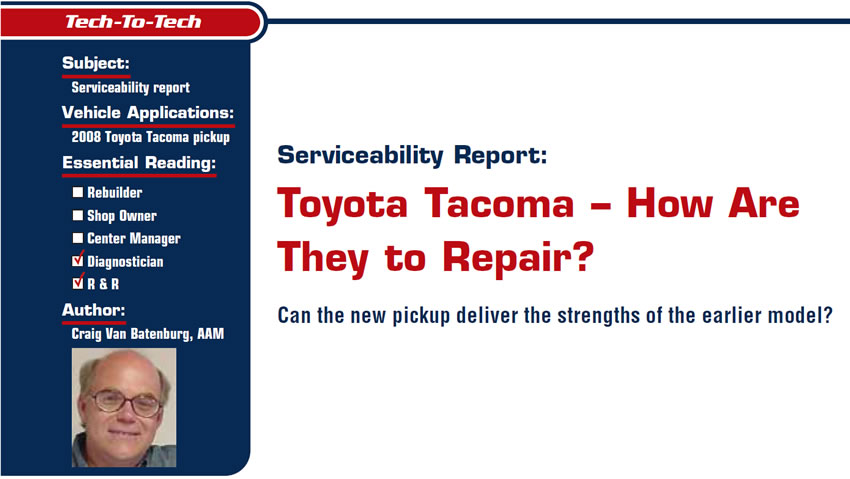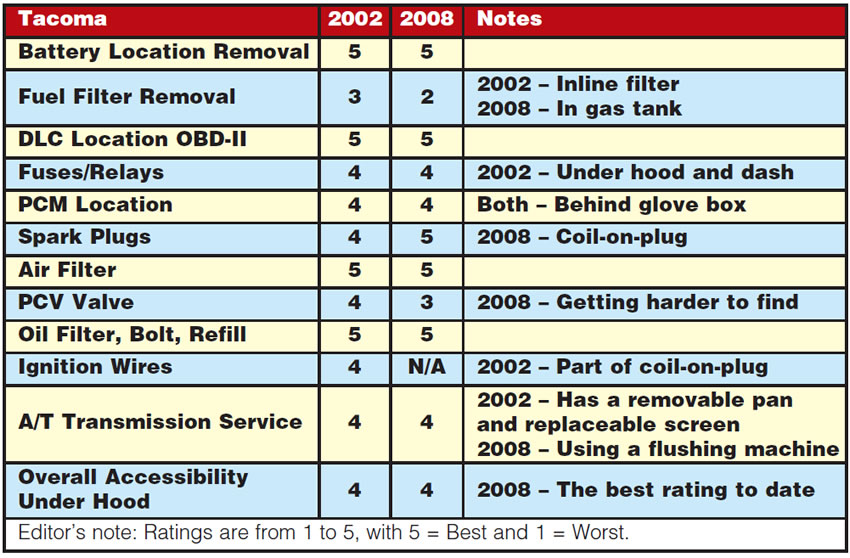
Tech-to-Tech
- Subject: Serviceability report
- Vehicle Application: 2008 Toyota Tacoma pickup
- Essential Reading: Diagnostician, R & R
- Author: Craig Van Batenburg, AAM
Can the new pickup deliver the strengths of the earlier model?
The top six car and truck companies in the United States are Toyota, GM, Ford, Honda, Chrysler and Nissan. The Civic is the best-selling vehicle. Big-truck and SUV sales are hurting. Mid-sized trucks are on an upward trend, and you will be seeing more of them in the future, so it makes sense to look at this segment.
In the early 1970s, I worked at Westboro Toyota as a technician and bought a brand-new 1972 Toyota Hi-Lux for under $2,300. The earlier-model Toyota truck was called a Stout. Hi-Lux and Stout are two names you don’t hear today. As an off-road motorcycle racer, my Hi-Lux was great. This little pickup truck came with a four-cylinder, 2.0L, SOHC engine known as an 18RC and produced 108 horsepower. It had a four-speed manual, and except for valve-train issues it was reliable and fun to drive.
Recently I went back to Westboro Toyota and bought another truck. Only this time it was $23,000. Just move the decimal point and add a zero to the end.
The new ACDC company truck has a 2.7-liter, 159-hp four-cylinder engine that provides 180 lb.-ft. of torque, a five-speed manual, good valve train and is fun to drive. Since the beginning, Toyota’s small-truck line has grown longer, wider and heavier with each new model. In the process it has become much safer with air bags and an antilock-braking system (ABS), faster with more horsepower and much, much cleaner at the tailpipe. Add a luxurious interior and sound system, and you have one popular pickup. But it still does the same job – haul my motorcycles.
We aren’t going to compare a 1972 to a 2008, but we will look at the 2008 vs. the 2002 model. The most popular is the V-6 with 4WD, but with gas prices not going below $4 a gallon, the four-cylinder is looking pretty good these days, and in regard to AWD – do I really need that?
Let’s start with the 2002 V-6 A/T AWD Tacoma. It used a 3.4-liter V-6 known as a 5VZFE. It had two important recalls. A protector for the fuel line was added so a side impact would not create a fuel spill, and some ball joints were defective. When I was doing my research I found lots of problems with the exhaust-gas-recirculation (EGR) system and air/fuel (A/F) sensors. It has a good motor that uses a timing belt with three coils directly on top of three spark plugs, with ignition cables feeding the other trio. The oil filter is side mounted, and most everything that is done underhood on a regular basis is relatively easy to get to. The shim-and-bucket valve train is solid and seldom needs adjusting. The old 3.0 V-6 used in earlier models was not loved by techs, as they not only had major mechanical problems but were not easy to service.

When we compare a 2002 to the 2008, the first thing you will notice is the size – it has grown a lot. Some older Tacoma owners have contacted Toyota to complain. They really liked their older model. The 2008 V-6 is a 4.0 liter, 236-hp DOHC that now uses chains and a coil for each spark plug. Owners best follow the advice of their tech-support people and get that oil changed on time, every time, as chain and sprocket replacement will set you back hundreds more than any timing belt ever would.
The oil filter is dropped in from the top with an aluminum funnel-shaped ring to collect the oil as it drains out of the old filter. A sharp punch with a well-placed whack on top of the oil filter will be used by many before twisting the can so that the oil will drain ahead of time. Some old tricks never die.
The positive-crankcase-ventilation (PCV) valve is threaded into the left valve cover so as to keep those pesky oil-change “newbies” from messing up a perfectly good oil change by installing the wrong PCV. Most just leave them alone now rather than fight with the part, just the way the Environmental Protection Agency envisioned it would be. Overall, this newly redesigned pickup is easy to service and the techs I interviewed had no complaints.
Overall rating for 2008 model: The quality is very good, but not perfect. The dash does not fit well together and needs work. The composite bed is not that old steel bed we all took for granted, so drilling holes to mount hooks and latches is not as easy as it has been for the last 100 years. The bed is rustproof, so that is progress. The tailgate is in need of a stiffener, as it will not support a lot of weight.
The drivetrain is one of the best in the business with good Web-site support from Toyota. The trusty old Mastertech scan tool with a controller-area-network (CAN) module and the latest software will do everything you need, as it was the factory tool in 2007. Starting in model year 2008, Toyota switched to a Denso-designed scan tool known as the TechStream. If the Toyota model was built in 2007 then the Mastertech will work. An example of that is a 2007 Camry hybrid electric vehicle (HEV); it is the same as the 2008, so you are all set with the older scan tool. If you are working on a Lexus LS 600h L HEV, then a TechStream is required, as it was new in model year 2008.
Remember that when you’re looking at the O2-sensor value in OBD-II generic, you will see about 0.5 volt. If you back-probe the front O2 sensor, you will see a reading of more than 3 volts. This is normal, so don’t replace the sensor or go looking for problems. On the factory side of the scan tool, you will see the real numbers for oxygen-content reporting. The reason for this is that the OBD-II rules require readings for O2 sensors to read between 0 and 1 volt. If you are not familiar with all the new fuel sensors being used in newer vehicles, find a class, book or DVD and get that training under your belt.
Ease of service is about average for most Toyota products. I have been consulting with some Tier One parts suppliers to the automakers and have spent days in meetings discussing hybrid technology. Somewhere in the conversation I mention this series of articles. I enjoy writing for AutoInc. and ask design engineers if they really do consider design in a serviceability context. Recently, I was glad to hear that parts manufacturers are being asked to design parts that are easier to remanufacture.

Craig Van Batenburg, AAM, is the owner of the Automotive Career Development Center (ACDC), www.autocareers.org, and delivers management and technical seminars nationwide. He formerly owned Van Batenburg’s Garage Inc. in Worcester, Mass., for more than 25 years. Van Batenburg is ASE master and L1 certified, with advanced skills in hybrid-drive systems. You can reach him by e-mail at [email protected].
This copyrighted article is reprinted with the permission of AutoInc., the official publication of the Automotive Service Association (ASA). To learn more about ASA and its commitment to independent automotive-service and repair professionals, visit www.ASAshop.org or call 800-272-7467.













